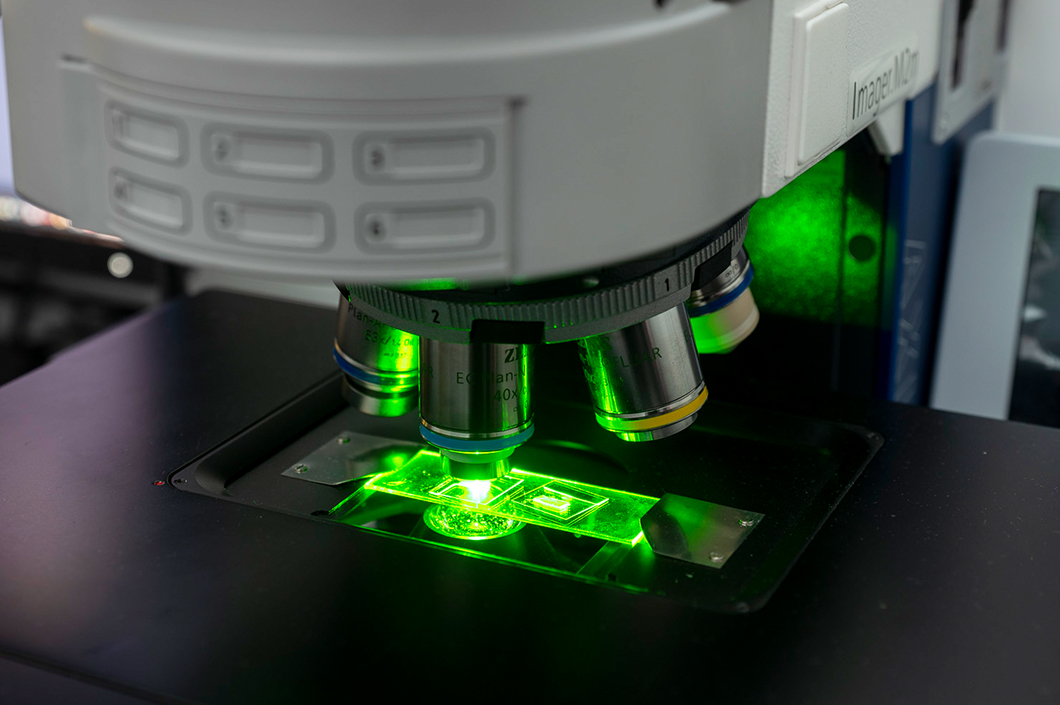
Processed with genicic sciessors, black fungi develop pink, orange or white mutants.
Source: Michael Danner
Black fungi damage valuable architectural monuments, colonise photovoltaic systems and can cause infections. Biocides often prove to be ineffective. A BAM team investigates the genetics of the microbes in order to develop new counterstrategies.
They are admirable survivors. Black fungi thrive on bare surfaces of glass, marble and concrete. They survive in the Sahara and in Antarctic sediments. They can even be found on the radioactively contaminated walls of the disaster reactor in Chernobyl.
But these microorganisms also have a very harmful feature: they decompose and discolour the surfaces to which they adhere. They penetrate the stone of precious and architectural historically significant buildings and cause them to burst from the inside. Recently they have also started to colonise photovoltaic systems and reduce their light yield and some species can infect animals and humans.

The microorganisms can colonise solar systems and can inpair thier light yield.
Source: BAM
Artificial deserts as ideal habitats
“It fascinates me to see how life finds its way even under the most adverse conditions on the one hand,” says Julia Schumacher, a molecular biologist at BAM. “However, I would like to contribute to limiting the damage caused by these organisms on the other.” Black fungi are considered to be 'extremotolerant' in the language of biology: they can survive almost completely without nutrients and water, even in habitats with high solar radiation for long periods of time. “Their strategy in times of scarcity is to ‘dim down’ their lives,” explains Schumacher. “If environmental conditions allow, they become active again and start cell division.”
Humans are creating more and more 'artificial deserts' as a result of climate change, the sealing of landscapes and the growth of cities. These are environments lacking water and protection from sunlight – ideal habitats for the resistant fungi that can survive for long periods without moisture and displace less tolerant microorganisms.
They have particularly thick cell walls reinforced with melanin and are surrounded on the outside by a protective layer of sugar molecules. The characteristic black pigment, melanin, absorbs the UV light, converts it into heat and thus prevents radiation, which is dangerous for all organisms, from entering the cell nucleus where it can cause deadly mutations.
The risk of cultivating super microbes
The microorganisms often form communities on exposed stone or glass surfaces with algae or cyanobacteria with which they form a streaky biofilm. Their melanin armour and outer slime layer protect not only themselves but also their partners from UV light and dehydration.
So far there has hardly been any effective remedy against black fungi. “If you wipe off the greenish-black film in which they survive, this mysteriously often stimulates their growth,” explains Julia Schumacher. Thus, it is still essential to combat them using biocides and fungicides.
However, excessive use of these chemicals can lead to the development of resistance against certain substance classes. “Fungi, like other microorganisms, react very quickly to external influences and do adapt,” says Schumacher. “It is therefore important to maintain the efficacy of the few available fungicides for as long as possible by using them carefully in order to be able to protect immunocompromised people against fungal infections. It is also important to avoid unintentionally growing super microbes – black fungi that are resistant to everything.”

Julia Schumacher is fascinated by the survival techniques of black fungi - and she is looking for solutions to limit the microbes' harmful potential.
Source: Michael Danner
The BAM scientist and her team have been using a modified approach: they want to investigate the genetics and thus the biology of these pests and therefore find their weak points. For a long time it was considered almost impossible to carry out genetic investigations on black fungi: the protective cell walls are too powerful and the growth is too slow for high-yield observations.
Pink mutants and fluorescent proteins
The BAM team is the first worldwide to have succeeded in gaining access to the cell nucleus of Knufia petricola, a typical black fungus which colonises and damages ancient marble in the Mediterranean region, and it now serves as a model organism.
Using genetic scissors, the researchers can quickly and efficiently remove or modify individual DNA segments in the fungal genome, for example, the sequence that is responsible for melanin synthesis. “The manipulated strains display an orange-red or pink colour in the laboratory because they can only produce carotenoids. When we also switched off an important gene for the synthesis of these pigments, white variants were produced,” says Schumacher. “Now we can check whether the mutants are more sensitive to biocides or UV radiation than the unaltered specimens. If so, it might be possible to increase the efficacy of biocides by simultaneously administering melanin synthesis inhibitors in order to better protect materials against black fungi. The approach itself is not new, but so far there has been no possibility of investigating the specific relationships in the laboratory.”

The team has inserted genes for red or green fluorescent proteins into the nucleus of Knufia petricola. The protein molecules begin to glow under the microscope.
Source: Michael Danner
BAM scientists have also succeeded in introducing genes for red or green fluorescent proteins into the cell nucleus of Knufia petricola. The protein molecules formed begin to glow under a special microscope. “This allows us to observe in real time when and how the cells divide. How they react to external stress factors such as temperature changes, UV light or biocides,” explains Schumacher.
The BAM research group also participates in an international integrated research project which aims to decode the genomes of 90 black fungi and feed the results into a joint database. “We are particularly interested in previously unknown genes for protective functions and the synthesis of new metabolic products”, says Schumacher. This cooperation also aims to gain a better understanding of the “extremotolerant” black fungi and one day develop effective counterstrategies based on this knowledge to protect buildings of architecturally historical significance, human health and solar power generation.


